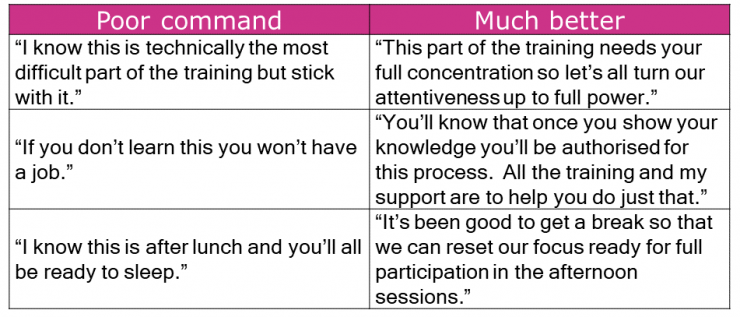10 training tips that work whether you're training 1 person or 1,000

Derek Robertson , CEO
(Chartered FCIPD, MCMI, MInstLM, NLP Practitioner and Coach)
8 min read
Some mates of mine tell me, “I could do that. You just talk to people.” Training people though is just as much a profession as accountancy or legal representation. Yet the science and art of effective training and meaningful value afterwards has often suffered from the opening quote. Maybe experiences of poor training colours people’s view. I’d propose that people experiencing quality training would never subscribe to my mates’ opinion.
What I’ll cover here has value to CEOs, the HR profession, commissioners of training and wannabe trainers.
Why? Because training is a key way to secure value, a return on investment and a more agile, confident and capable workforce.
So let’s explore the ten tips. I’ve also included possible actions for you. Once you apply them consistently they will deliver meaningful value to you, the people you train and your organisation. What’s not to like?
Training?
CIPD define training as, “An instructor-led, content-based intervention designed to lead to skills or behaviour change1.” So, whether it’s leadership development or business skills with everything from chairing meetings, to behaving assertively training is present.
The 10 things
#1 Do it just in time
Like comedy, training is all about timing. Adults need training that they can apply straight away. Too big a gap between the learning and application and your training investment fritters away. Investing too long after the need arose means you’ve fallen into the “Just too late” training trap.
Action
Review your ways to identify training to make sure they are more Billy Connolly than Mr Bean.
#2 Have measurable objectives
You don’t need a masters in training and development to know that if your training objectives aren’t measurable you’ve no way to assess if the training delivered. Notice the difference here.

Action
Make sure all your training objectives are measurable.
#3 Focus on the prize
Help your learners’ motivation by painting a picture of success. “When you apply this training you will be able to . . .” is a great place to start.
Even better, have them create their own vivid picture of success. We have our participants do it in terms of what they will see, hear and feel when they are successful.
Action
Have all learners start with the end in mind with a positive vision of what’s in it for them when they apply their training.
#4 Get the environment right
This is less about the room, virtual or otherwise, and more about creating the low stress high expectation environment where your adults’ brains are open, ready to take in the training content. You want them relaxed and aware.
Here are four big hitters.
Positive emotions
Give your people an experience that is full of positive emotional impact. Everything from your positive affirmations or quotations, activities that have them work on their own (without the trainer as a kind of prison guard micro managing every detail). Include testimonials from previous learners sharing the value they got from the same training.
Talk constructively at all times
Focus on what can be done, what’s been achieved and what could be better. Find the upsides in everything they do or produce. If you need to feedback on what didn’t work ask them first. Then you can follow up with coaching questions to help them notice for themselves what to do differently.
Only use constructive embedded commands
The technicalities of this are for another blog. Here are some examples that show you the way.

Reviewing these poor embedded commands, ask yourself, “What has the trainer given the learners permission to do?”
Avoid stress inducing language
Classics here are the language of “you must” or “you have to”. Same with referencing a “test” or “assessment
Subtle assessments
Unless there is a firm reason, such as financial services training requires meeting a pass mark, keep your assessments subtle. This is where creativity can run wild from ‘Who wants to be a millionaire’ type quizzes to missing words and thousands of options in between.
When your assessments are subtle your learners get confidence boosts from showing they know instead of shaken confidence from introducing needless stress.
Action
Pay very close attention to the environment your training creates. You’re wasting money and time if you contribute to learner stress, pressure or the inkling of boredom ahead.
#5 Deliver a multi-sensory experience
It’s no surprise that we call the talking head approach as ‘Pour and snore training’. Don’t do it. Humans weren’t created as empty vessels waiting to be filled with training. Instead we need to engage our emotions and senses to make it super easy to take in new information and then process it deeply. Colin Rose summed it up with “Learning is created not consumed.”
Action
Make sure your designs have the training ball in the learners’ court for at least 70% or the time.
#6 Provide the keys
Had Lao Tzu been a training professional he’d have reworked one of his quotes to, “Give your trainees the content by repetition and they’ll pass the course test. Give them the keys and you’ll enable them to deliver, improve and innovate for their whole careers.”
I can best show this as an example. In our train the trainer programme participants train one another in a new numbering system. The trainers whose approach is, “Do this, then this, then this” get some success and eventually meet the training objective. The trainers that provide or even better have the trainees work out, the keys to the system get amazing results with participants able to quickly go beyond the stated brief and, take my word for it, feel brilliant about themselves for over-achieving.
Yet they shouldn’t see it as over-achieving but as their trainer doing their core job to simplify complexity into straightforward rules. Or the keys as we describe it.
Action
Review your training provision to see to see where it sits between ‘getting by’ and ‘enabling high performance’.
#7 Keep it real
Adult learning principles demand real life issues to them. So give them real problems to solve. Now, we do have case studies based on Jupiter or fictitious companies. That’s ok if there is a legitimate design reason for it. The issues though, even in made up case studies, are realistic and relevant to the real life issues faced by learners.
Nothing hampers learner engagement and so learning more than thoughts of “What has this to do with me?”
Action
Make sure all your training designs keep it real for the learners.
#8 Use their experience
Your learners bring all their life and working experience to their training. I reckon a big part of learners perceiving training as boring is because the training doesn’t tap into their experience.
Simple coaching questions work such as:
- Where might you apply what we’ve just covered in your job?
- How might you need to evolve this approach to suit your work situation?
- What’s a work situation where this content might not apply? And so what might you do about that?
Action
Make sure to tap into your learners’ experience.
#9 Apply from tomorrow
Donald Miller tells us that your brain is only interested in what will help it survive and thrive. All your adult learners are therefore asking themselves “Is this useful to me?” and “Can I use this tomorrow?”
Your training should compel your learners’ brain to burn vital calories to think about their new learning and how to best use it.
Enter the world of checklists, job aids, cheat sheets and so on. Plus of course the trainer facilitating discussion on how learners will apply it from tomorrow!
Action
Assess how well your designs and delivery address the issue of immediate application.
#10 Close the loop
Adults need you to close the loop on what they’ve achieved. And that’s quite apart from your business need to make sure you get value from your training investment. Practical things here are:
- Returning to the measurable objectives to make sure they were met. Your options include simply asking the learners through to using your subtle assessments data.
- Have learners work out their success. This is much more powerful than the trainer telling them.
- Ask them to review (evaluate) the value they got and their intended results. This has an extra benefit of focusing them on workplace action too.
Actions
Don’t let the training fizzle out. Spend as much effort on closing the loop as making a great start.
The key takeaway is that ‘Sit down face front listen to me’ is taking the training sledgehammer to crack a nut. Using all that we know about neuroscience, adult learning and common sense we can make training enjoyable fast and effective, whether it’s one learner or 1,000.
Of course if it’s not your core job to be expert in these things find a training partner who is expert. Our free download 6 Secrets to choosing a training provider can help you still further.
The prize is consistently effective and meaningful training from all your business skills, leadership and team development. And the supercharging benefit of having ever-more capable, confident and agile learners. That delivers a workforce ready nimbly pivot as the pace of change accelerates.
If this blog gave you actions: great. That was my intention. The team and I at Robertson Training want you to succeed.
If it didn’t challenge you, I’d love to feature your achieving consistently meaningful training results in an interview about great training practice.
Sources and notes
CIPD Factsheet, ‘Learning methods’
https://www.cipd.co.uk/knowledge/fundamentals/people/development/learning-methods-factsheet

